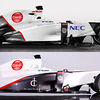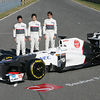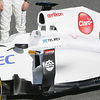Sauber takes wraps off of C31 at Jerez

Sauber Motorsport has given the honour to its drivers Kamui Kobayashi and Sergio Pérez to unveil the new 2012 machine. Dubbed the C31, the new car sports a slightly modified livery but retains a clean and seemingly simple aerodynamic design.
The Sauber F1 Team will enter its 20th season in the FIA Formula One World Championship spearheaded by an unchanged driver line-up. With Kamui Kobayashi, Sergio Pérez and reserve driver Esteban Gutiérrez piloting the new Sauber C31-Ferrari, the Swiss outfit will be looking to further improve in 2012. “We’re aiming to start the new season as strongly as we did in 2011, but then also to maintain this level of performance throughout the year,” explains Team Principal Peter Sauber. “Our goal is to finish regularly in the points so as to put ourselves in a significantly better position in the World Championship.”
Only three of their rivals on this year’s grid have been in Formula One longer than Peter Sauber’s team. After an excellent start to 2011, the team’s form fell away mid-way through the season following the decision to cease development of a controversial technology. “The Sauber C31-Ferrari boasts a large number of promising new developments, but in other areas it is a systematic further development of last year’s car,” says Sauber.
“We are looking forward to another season working with our young and talented drivers,” adds the Team Principal. “Kamui will be competing in his third full season in F1. Last year we asked him to take on leadership responsibilities within the team and he has grown into the role. With his rookie season behind him Sergio is now approaching his second season, which is often the most difficult in a driver’s Formula One career. Both drivers have huge potential and will work with the same race engineers as in 2011 to continue developing that promise. Esteban will be competing full-time in GP2 in his second season in the category and has shown – most recently in the November test – that he could also step into the car for a Grand Prix, if required.”
The driversThe personable Kamui Kobayashi (25) became an instant favourite of Formula One fans on his arrival in the sport, not least with his daring but fair overtaking moves. “2012 will be not only my third season in Formula One, but also my third with the same team,” says the young Japanese. “We’ve been through a lot together and can benefit from our shared experiences. In my first year with the team we had a bad start but a good second half to the season. The second year was the exact reverse. In our third year together we should be a reliable bet to finish consistently in the points. I’m really looking forward to the new season with the Sauber F1 Team.”
In 2012 Sergio Pérez (22) is setting out to put the lessons from a turbulent but impressive rookie season in 2011 into practice. “My first year in Formula One felt like three years, there were so many new things to take in,” admits the Mexican. “But now I feel like I’ve arrived in Formula One and I’m determined to take a step up in 2012 and achieve better results for the team on a regular basis.”
20-year-old Esteban Gutiérrez will be focusing on the races in the GP2 Series. “At the same time,” says the team’s other Mexican driver, “I’m looking forward to working more with the Sauber F1 Team. I’m learning a lot by being able to experience and analyse the professionalism and intensity of the team’s work from the inside. It’s good preparation for me.”
Car characteristicsSummarising all the efforts put into developing the new Sauber C31-Ferrari, Chief Designer Matt Morris says: “The C31 is revolutionary where we had fresh ideas, particularly at the rear of the car, and it is an evolution where we knew we could carry over certain approaches. We had to improve on the weaknesses we identified on the C30, but at the same time we wanted to maintain its strengths.”
The engineers opted again to go with a high chassis design. However, according to the new 2012 regulations, the nose cone needs to be lower, which is a safety requirement. As a result, the nose cone has quite a different shape to how it was in the past. The chassis itself shows absolute minimum cross sections all the way to the cockpit.
By an overall tidier design, the front suspension has been optimised for integration with the chassis and the upright. Otherwise it’s a traditional layout with a pushrod and a high-level wishbone.
Packaging was further optimised under the side pods in order to open up more aerodynamic development scope in that area. The cooling layout is based around a similar philosophy to the C30, because that proved to be effective. It helps to get the volume of the coolers forward and allows the design of very compact rear bodywork.
A familiar element of the car is the Ferrari engine, onto which an all-new carbon transmission is bolted – also supplied by Ferrari. The longitudinally mounted transmission is a very tidy, neat unit. The entire rear of the car is much more tightly packaged, helped by the gearbox design, and in addition the engineers have gone in some new directions around the floor at the back of the car. The exhaust tailpipe positions are regulated in 2012, which has had a further effect on how the bodywork design has been set out.
The rear suspension is now a pullrod design. It shows a long pullrod towards the front of the gearbox and wide angled wishbones. This design allows improved packaging of the rear spring and damper elements. Despite the change from pushrod to pullrod, in terms of kinematics the engineers maintained a similar direction to the one they went in for the C30.
Finally, Morris casts a glance at the next steps after the roll-out of the Sauber C31-Ferrari: “The current plan is to launch a fairly basic roll-out version of the car, which was defined quite some time ago. We will then be testing development parts during the upcoming weeks with a late upgrade for the first race on 18th March in Australia. Therefore the car will look quite different in Melbourne compared to the roll-out car.”







